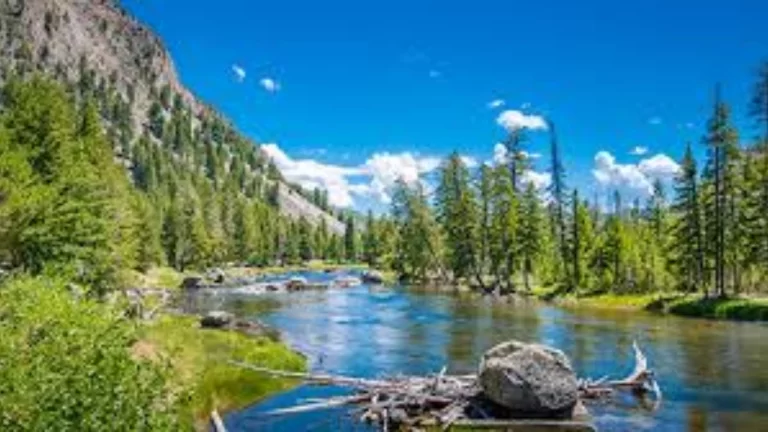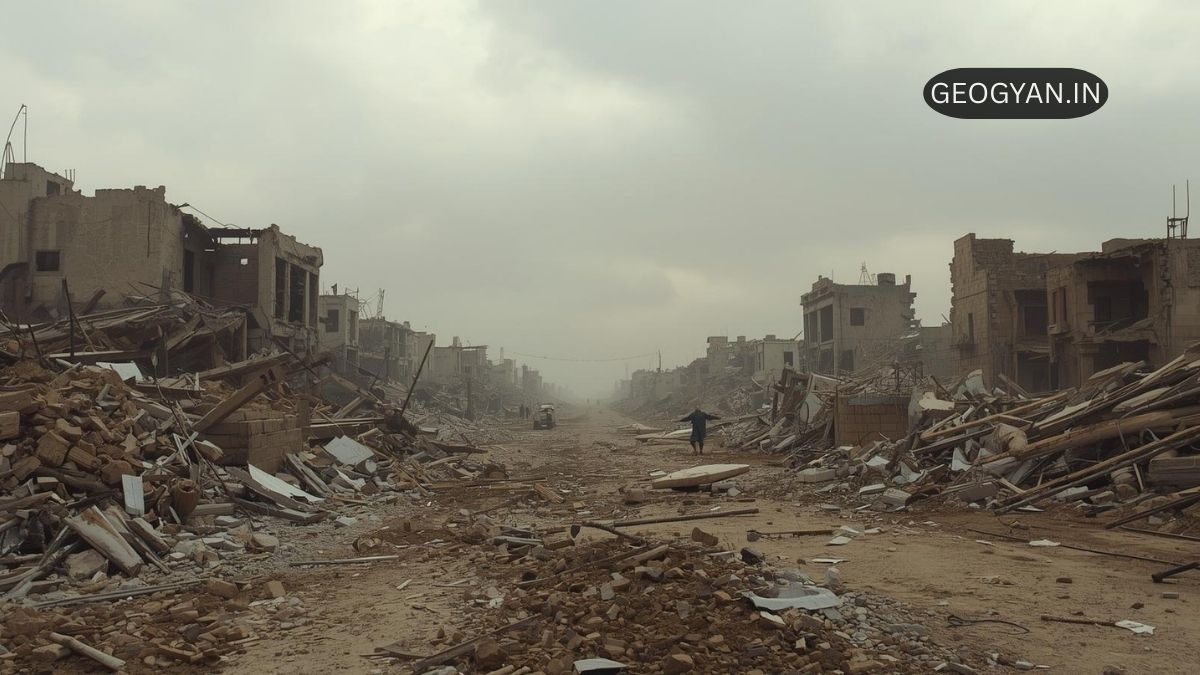Exercise
Access the latest NCERT Solutions for Class 7 Geography Chapter-4: Air, updated for 2024-2025. Solution is designed to help students tackle difficult questions with ease. The content is written in simple, easy-to-understand language.
1. Answer the following questions:
(i) What is atmosphere?
The atmosphere is a huge blanket of air that surrounds the Earth. It provides the air we breathe and protects us from the harmful rays of the sun.
(ii) Which two gases make the bulk of the atmosphere?
Nitrogen and oxygen make up the bulk of the atmosphere.
(iii) Which gas creates the greenhouse effect in the atmosphere?
Carbon dioxide creates the greenhouse effect by trapping heat in the atmosphere.
(iv) What is weather?
Weather is the day-to-day condition of the atmosphere at any place.
(v) Name three types of rainfall.
The three types of rainfall are convectional rainfall, orographic rainfall, and cyclonic rainfall.
(vi) What is air pressure?
Air pressure is the pressure exerted by the weight of air on the Earth’s surface.
2. Tick the correct answer:
(i) Which of the following gases protects us from harmful sun rays?
(a) Carbon dioxide
(b) Nitrogen
(c) Ozone
(ii) The most important layer of the atmosphere is
(a) Troposphere ☑
(b) Thermosphere
(c) Mesosphere
(iii) Which of the following layers of the atmosphere is free from clouds?
(a) Troposphere
(b) Stratosphere ☑
(c) Mesosphere
(iv) As we go up the layers of the atmosphere, the pressure
(a) Increases
(b) Decreases ☑
(c) Remains the same
(v) When precipitation comes down to the earth in the liquid form, it is called
(a) Cloud
(b) Rain ☑
(c) Snow
3. Match the following:
(i) Trade Winds (a) Incoming solar energy
(ii) Loo (b) Seasonal wind
(iii) Monsoon (c) Horizontal movement of Air
(iv) Wind (d) Layer of ozone gas
(e) Permanent wind
(f) Local wind
Ans.
(i) Trade Winds – (e) Permanent wind
(ii) Loo – (f) Local wind
(iii) Monsoon – (b) Seasonal wind
(iv) Wind – (c) Horizontal movement of Air
4. Give reasons:
(i) Why do wet clothes take longer time to dry on a humid day?
On a humid day, the air is already full of moisture, so it cannot absorb more water vapor from the clothes, making them take longer to dry.
(ii) Why does the amount of insolation decrease from the equator towards the poles?
The amount of insolation decreases from the equator towards the poles because the sun’s rays strike the Earth’s surface at a lower angle as we move away from the equator, spreading the energy over a larger area.
Other Important Short answer Type Questions
Here are important short answer-type questions based on Chapter 4: Air from the NCERT Class 7 Geography book. These questions go beyond the exercise section and are formulated to align with previous years’ NCERT 7th class and UPSC examinations.
1. What is the importance of the atmosphere for life on Earth?
The atmosphere is a blanket of air surrounding Earth. It plays a crucial role in supporting life by providing oxygen for respiration, protecting living beings from harmful sun rays, and regulating Earth’s temperature. Without the atmosphere, Earth would experience extreme temperatures, making it uninhabitable for living organisms.
2. Explain the composition of the atmosphere.
The atmosphere is primarily made up of nitrogen (78%) and oxygen (21%), which are essential for life. Other gases like carbon dioxide, argon, helium, and hydrogen are present in smaller quantities. The air also contains tiny dust particles. This composition allows various life processes and climatic phenomena to occur.
3. How does carbon dioxide contribute to the greenhouse effect and global warming?
Carbon dioxide traps heat in the Earth’s atmosphere, contributing to the greenhouse effect. While it helps keep Earth warm enough for life, excessive carbon dioxide from burning fossil fuels increases Earth’s temperature, leading to global warming. This results in melting ice caps, rising sea levels, and changes in climate patterns.
4. What role does nitrogen play in the atmosphere, and how do plants use it?
Nitrogen is the most abundant gas in the atmosphere, but plants cannot absorb it directly. Special bacteria in soil and plant roots convert atmospheric nitrogen into a form that plants can use for growth. This nitrogen-fixing process is vital for plant survival and is essential for maintaining the nitrogen cycle.
5. Describe the structure of the atmosphere and its layers.
The atmosphere is divided into five layers:
- Troposphere – Extends up to 13 km; contains the air we breathe and weather phenomena like rain and storms.
- Stratosphere – Up to 50 km; contains the ozone layer.
- Mesosphere – Up to 80 km; where meteorites burn.
- Thermosphere – Temperature rises with height, important for radio transmission.
- Exosphere – The outermost layer with thin air.
6. How does air pressure vary with height, and what is its effect on weather?
Air pressure is the force exerted by the weight of air on Earth’s surface. It is highest at sea level and decreases with height. Low-pressure areas are created when air heats and rises, often resulting in cloudy or wet weather. In contrast, high-pressure areas bring clear and sunny conditions.
7. What is wind, and how does it form?
Wind is the movement of air from areas of high pressure to low pressure. It is formed due to differences in air pressure, which result from temperature variations. Winds can vary from gentle breezes to strong storms, influencing weather patterns and helping to circulate heat around the globe.
8. What are permanent, seasonal, and local winds? Provide examples.
- Permanent winds blow constantly in the same direction year-round, such as the trade winds.
- Seasonal winds change direction in different seasons, like monsoon winds in India.
- Local winds blow during specific periods in small areas, such as the hot, dry “loo” in northern India during summer.
9. Explain how humidity affects weather.
Humidity refers to the amount of water vapor present in the air. On humid days, when the air is full of moisture, it can feel uncomfortable as sweat doesn’t evaporate easily. High humidity often indicates the possibility of rain. As the air becomes warmer, it holds more moisture, leading to increased humidity.
10. How does rainfall occur, and what are its types?
Rainfall occurs when water vapor in the air condenses into water droplets that become too heavy to remain in the atmosphere. There are three types of rainfall:
- Convectional rainfall – Occurs due to intense heating of the surface.
- Orographic rainfall – Occurs when moist air is forced to rise over mountains.
- Cyclonic rainfall – Results from the meeting of warm and cold air masses.
MCQs on “Air”:
Here are 20 MCQs based on Chapter 4: Air from NCERT Class 7th Geography, designed to help students in NCERT 7th class examinations and UPSC. The answers are provided at the end.
- What is the layer of air surrounding the Earth called?
(a) Lithosphere
(b) Atmosphere
(c) Hydrosphere
(d) Biosphere - Which gas makes up the largest portion of Earth’s atmosphere?
(a) Oxygen
(b) Carbon dioxide
(c) Nitrogen
(d) Helium - Which gas is responsible for the greenhouse effect in the atmosphere?
(a) Oxygen
(b) Ozone
(c) Nitrogen
(d) Carbon dioxide - Which atmospheric layer is most important for weather phenomena?
(a) Stratosphere
(b) Troposphere
(c) Mesosphere
(d) Exosphere - Which layer of the atmosphere contains the ozone layer?
(a) Troposphere
(b) Stratosphere
(c) Mesosphere
(d) Thermosphere - What happens to air pressure as we go higher in the atmosphere?
(a) Increases
(b) Decreases
(c) Remains the same
(d) Fluctuates - What is the movement of air from high-pressure areas to low-pressure areas called?
(a) Rainfall
(b) Wind
(c) Cyclone
(d) Evaporation - Which of the following is a permanent wind?
(a) Loo
(b) Monsoon
(c) Westerlies
(d) Sea breeze - Which form of precipitation occurs in liquid form?
(a) Snow
(b) Rain
(c) Hail
(d) Sleet - What is the incoming solar energy intercepted by the Earth called?
(a) Insolation
(b) Radiation
(c) Evaporation
(d) Convection - Which instrument is used to measure atmospheric pressure?
(a) Thermometer
(b) Hygrometer
(c) Barometer
(d) Rain gauge - Which wind blows from the sea to the land during the day?
(a) Land breeze
(b) Sea breeze
(c) Westerly winds
(d) Cyclonic winds - What is the term for the amount of water vapor in the air?
(a) Precipitation
(b) Humidity
(c) Wind pressure
(d) Evaporation - Which process helps plants use nitrogen from the air?
(a) Photosynthesis
(b) Nitrogen fixation by bacteria
(c) Respiration
(d) Evaporation - Which type of rainfall occurs due to the upward movement of warm air?
(a) Orographic rainfall
(b) Cyclonic rainfall
(c) Convectional rainfall
(d) Relief rainfall - Which gas is essential for the survival of humans and animals?
(a) Nitrogen
(b) Oxygen
(c) Carbon dioxide
(d) Argon - Which local wind is known for its hot and dry nature in Northern India?
(a) Monsoon
(b) Loo
(c) Westerlies
(d) Trade winds - What happens to the temperature as you move from the equator to the poles?
(a) Increases
(b) Decreases
(c) Remains constant
(d) Fluctuates - Which layer of the atmosphere helps in radio transmission?
(a) Stratosphere
(b) Mesosphere
(c) Ionosphere
(d) Exosphere - Which atmospheric condition is referred to as weather?
(a) Long-term average weather patterns
(b) Hour-to-hour and day-to-day atmospheric conditions
(c) Seasonal wind changes
(d) Movement of the Earth’s plates
Answers:
- (b)
- (c)
- (d)
- (b)
- (b)
- (b)
- (b)
- (c)
- (b)
- (a)
- (c)
- (b)
- (b)
- (b)
- (c)
- (b)
- (b)
- (b)
- (c)
- (b)
Other Chapters
| Chapter 1:- Environment | Chapter 2:- Inside Our Earth |
| Chapter 3:- Our Changing Earth | Chapter 5:- Water |
| Chapter 6:- Human Environment | Chapter: 7- Life in the Deserts |




























